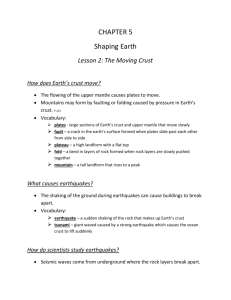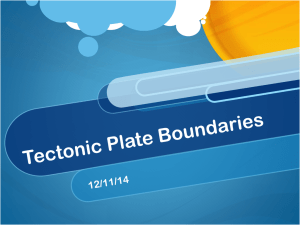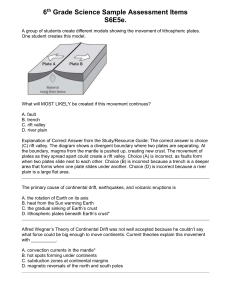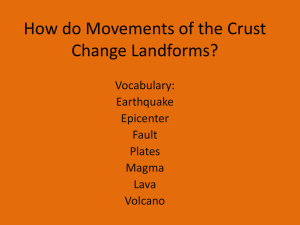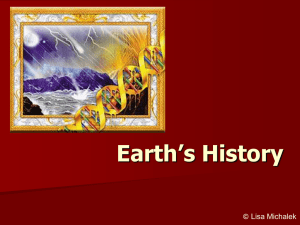Science department Grade 7 Final revision sheet quarter 2 Name
advertisement
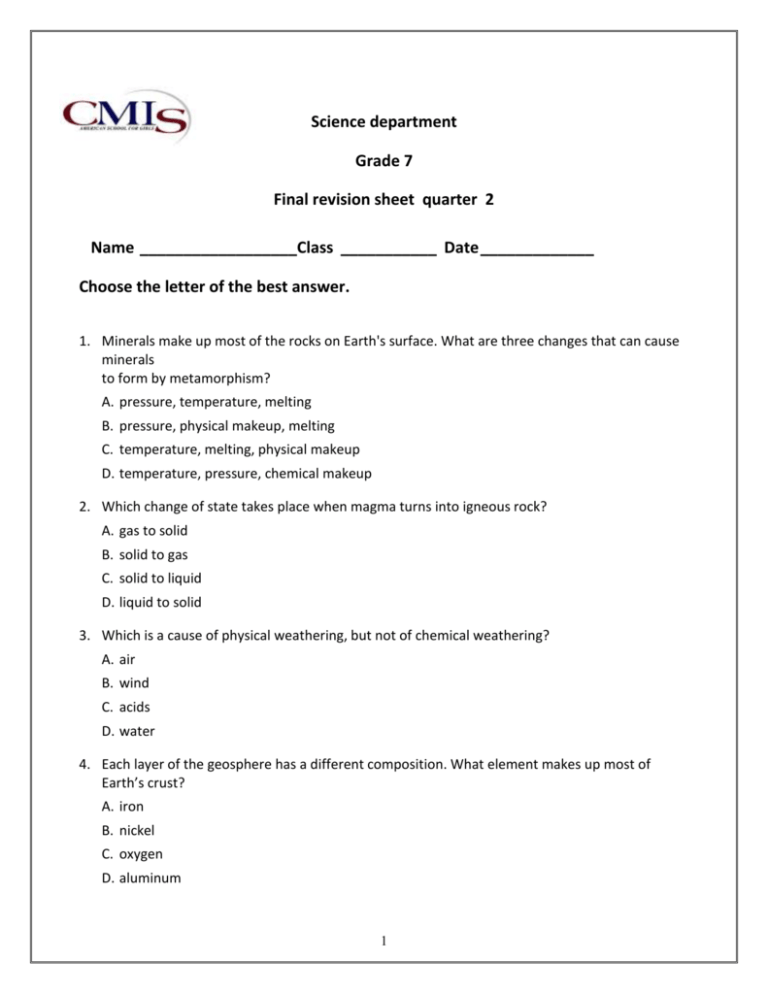
Science department Grade 7 Final revision sheet quarter 2 Name __________________Class ___________ Date _____________ Choose the letter of the best answer. 1. Minerals make up most of the rocks on Earth's surface. What are three changes that can cause minerals to form by metamorphism? A. pressure, temperature, melting B. pressure, physical makeup, melting C. temperature, melting, physical makeup D. temperature, pressure, chemical makeup 2. Which change of state takes place when magma turns into igneous rock? A. gas to solid B. solid to gas C. solid to liquid D. liquid to solid 3. Which is a cause of physical weathering, but not of chemical weathering? A. air B. wind C. acids D. water 4. Each layer of the geosphere has a different composition. What element makes up most of Earth’s crust? A. iron B. nickel C. oxygen D. aluminum 1 5. What are two processes that result in rocks being broken down into smaller pieces? A. sunlight and glacial melting B. chemical weathering and physical weathering C. chemical weathering and deposition D. physical weathering and humus 6. The table below lists five classes of nonsilicate minerals. Class Description Example Carbonates contain carbon and oxygen compounds calcite Halides contain ions of chlorine, fluorine, iodine, and bromine halite Native elements contain only one type of atom gold Oxides contain oxygen compounds hematite Sulfides contain sulfur compounds pyrite There are actually six classes of nonsilicate minerals. Which class is missing from this chart? A. feldspars C. silicates B. micas D. sulfates 7. Granite can form when magma cools within Earth. Basalt can form when lava cools on Earth’s surface. What do granite and basalt have in common? A. They are igneous. B. They are old. C. They are fossils. D. They are intrusive 8. A student is testing a mineral in science class. What property of the mineral is the student testing? A. cleavage C. luster B. color D. streak 2 9. Which one of the following statements about elements, atoms, and compounds is not true? A. Elements consist of one type of atom and can combine to form compounds. B. Compounds are smaller than atoms. C. Elements and compounds form the basis of all materials on Earth. D. Atoms cannot be broken down into smaller substances. 10. Which of the following best describes how sedimentary rock forms? A. molten rock beneath the surface of Earth cools and becomes solid B. layers of sediment become compressed over time to form rock C. chemical processes or changes in pressure or temperature change a rock D. molten rock reaches the surface and cools to become solid rock 11. Study the diagram below. What process is occurring in this image? A. two tectonic plates are moving toward each other, creating a syncline B. two tectonic plates are pulling away from each other, creating a rift zone C. two tectonic plates are moving toward each other, creating an anticline D. two tectonic plates are moving away from each other, creating a new mountain range. 12. Over time, repeated temperature changes can cause a rock to break down into smaller pieces. What is this an example of? A. subsidence B. deposition C. weathering D. erosion 13. Landslides, rockfalls, and creep are examples of erosion and deposition by which erosion agent? A. gravity B. oxidation C. solar energy D. wind 3 14.Which physical change takes place when an igneous rock turns into sedimentary rock? A. weathering B. deformation C. pressure increases D. temperature decreases 15. Minerals make up most of the rocks on Earth's surface. What is the difference between minerals that form from magma and those that form by metamorphism? A. Minerals that form from magma change their composition. B. Minerals that form from magma change from liquid to solid. C. Minerals that form from magma are altered by intense pressure. D. Minerals that form from magma are hotter than metamorphosed minerals. 16. Tectonic plates are made of continental crust, oceanic crust, or a combination of the two. Besides their locations, how else are these two kinds of crust different? A. Tectonic plates made of continental crust are larger than plates made of oceanic crust. B. Tectonic plates made of continental crust are smaller than plates made of oceanic crust. C. Continental crust is thicker than oceanic plates. D. Continental crust is thinner than oceanic crust. 17. What happens at a divergent tectonic plate boundary? A. Two tectonic plates move horizontally past one another. B. Two tectonic plates pull away from each other, forming a rift valley or mid-ocean ridge. C. Two tectonic plates come together to form one plate. D. Two tectonic plates collide, causing subduction. 18. Which of the following is a major difference between Earth’s inner core and Earth’s outer core? A. the inner core is liquid and the outer core is solid B. the inner core is solid and the outer core is liquid C. the inner core is gas and the outer core is solid D. the inner core is solid and the outer core is gas 19. Which of the following describes magma? A. solid rock B. molten rock C. volcanic ash D. volcanic cone 4 20. Most divergent plate boundaries lie under the world’s oceans. Which of the following is a process that occurs at divergent boundaries? A. subduction of old crust B. formation of new crust C. plates slide past each other D. continental collisions occur 21. Scientists divide Earth into three main layers. Each layer has a different chemical composition. Which is the innermost layer of Earth? A. Earth’s innermost layer is the core. B. Earth’s innermost layer is the mantle. C. Earth’s innermost layer is the lithosphere. D. Earth’s innermost layer is the asthenosphere. 22.Notice how the figure below shows both continental crust and oceanic crust. In this figure, shading indicates density. The more darkly shaded a region is, the denser that region is. What can you infer from the figure? A. Oceanic crust is denser than continental crust. B. Continental crust is denser than oceanic crust. C. Oceanic crust does not contain as much iron as continental crust. D. Continental crust contains more magnesium than oceanic crust. 23. Convection currents in the mantle contribute to tectonic plate movement. What is a convection current? A. the transfer of energy by direct contact B. the transfer of energy by the movement of matter C. the transfer of energy through a solid, such as the Earth’s crust D. the transfer of energy from a region of lower temperature to a region of higher temperature 5 24. The diagram below shows Earth divided into five layers. Scientists divide Earth into these layers based on what properties? A. core properties B. physical properties C. chemical properties D. atmospheric properties 25. What happens at a convergent tectonic plate boundary? A. One tectonic plate pulls apart into two new plates, forming a rift or ridge. B. Two tectonic plates pull away from one another, decreasing rock deformation. C. Two tectonic plates collide with one another, causing subduction and/or mountain building. D. Two tectonic plates slide horizontally past each other along Earth’s surface, forming long fault lines. 26 .Earth’s three compositional layers are the mantle, core, and crust. Which statement below is correct? A. A is the crust, B is the core, and C is the mantle. B. A is the core, B is the mantle, and C is the crust. C. A is the inner core, B is the outer core, and C is the mantle. D. A is the core, B is the crust, and C is the mantle. 6 27. Earth can be divided into five layers: lithosphere, asthenosphere, mesosphere, outer core, and inner core. Which properties are used to make these divisions? A. compositional properties B. chemical properties C. physical properties D. elemental properties Answer the following questions in the space provided. 1. Explain how a convergent boundary is different from a transform boundary. Then, name one thing that commonly occurs along both convergent boundaries and transform boundaries. _____________________________________________________________________________ _____________________________________________________________________________ _____________________________________________________________________________ _____________________________________________________________________________ _____________________________________________________________________________ _____________________________________________________________________________ 2. The diagram below shows the five physical layers of Earth. Identify the physical layers A, B, and C. Describe the relationship between these layers . _____________________________________________________________________________ _____________________________________________________________________________ _____________________________________________________________________________ _____________________________________________________________________________ 7 3. Explain whether water is a cause of either chemical weathering, physical weathering, or both. _____________________________________________________________________________ _____________________________________________________________________________ _____________________________________________________________________________ _____________________________________________________________________________ _____________________________________________________________________________ 4. What factors cause physical weathering? _____________________________________________________________________________ _____________________________________________________________________________ 5. What factors cause chemical weathering ? _____________________________________________________________________________ _____________________________________________________________________________ 7. What processes can change rocks ? _____________________________________________________________________________ _____________________________________________________________________________ 8. List the three types of rocks . _____________________________________________________________________________ _____________________________________________________________________________ 9. List the five spheres of earth. _____________________________________________________________________________ _____________________________________________________________________________ 10. What factors affect the ability of a stream to erode materials ? _____________________________________________________________________________ _____________________________________________________________________________ 8 11. The diagram below shows the rock cycle. The rock cycle describes how rocks change. What conditions must be present for igneous or sedimentary rock to change into metamorphic rock? Name two ways that this could happen. _____________________________________________________________________________ _____________________________________________________________________________ _____________________________________________________________________________ 12-All chemicals can be classified as elements or compounds. Describe how elements and compounds are different. ___________________________________________________ ___________________________________________________ 13-Classify quartz and diamond as either elements or compounds. _______________________ ________________________ 9

